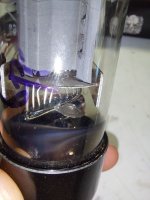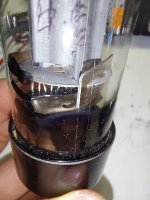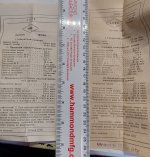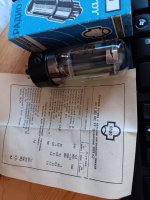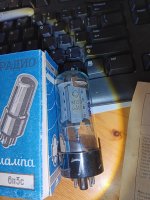I have a home brew stereo, cathode biased push pull amp with octal power tube sockets, a single 12ax7 per channel for AF stage/phase splitter and Fisher 7591A OTs (30:1 turns ratio). I’m running 6L6GCs now with 480R cathode resistors, a 305 volt Maida screen regulator and a 405 volt plate.
I have a set of new 6Π3C tubes (not 6Π3C-E mind you). I gather they are 6L6GA ish. Do you think I could substitute these at that plate and screen potential without shorting them? I have some 680R cathode resistors to dial down the current some.
Any local knowledge regarding these 6Π3C tubes would be appreciated.
I have a set of new 6Π3C tubes (not 6Π3C-E mind you). I gather they are 6L6GA ish. Do you think I could substitute these at that plate and screen potential without shorting them? I have some 680R cathode resistors to dial down the current some.
Any local knowledge regarding these 6Π3C tubes would be appreciated.
Last edited:
The 6N3 is a standard version, though maybe lightweight, of a 6L6GT.
Voltages are not the problem, the thickness of the anode plus overall area and the cathode coating is the difference along with the smaller glass bottle.
The anode dissipation is around 19W whereas the GC dissipated up to 28W.
Perfectly serviceable for replacements if peak power is not required; 6L6 pair = 45W and 6L6GC 65W, in push pull as a pair.
The anode impedance is the same as is the bias voltage. They will work quite happily up to 700 volts on the anodes, as the GC and 5881 do.
Voltages are not the problem, the thickness of the anode plus overall area and the cathode coating is the difference along with the smaller glass bottle.
The anode dissipation is around 19W whereas the GC dissipated up to 28W.
Perfectly serviceable for replacements if peak power is not required; 6L6 pair = 45W and 6L6GC 65W, in push pull as a pair.
The anode impedance is the same as is the bias voltage. They will work quite happily up to 700 volts on the anodes, as the GC and 5881 do.
Thanks Jon. How about the screen voltage? I can’t make out the datasheet. The 6L6GT is 250v. That’s why I put in the screen regulator [but it’s set at 300].
And Yeah, we’re talking about the 6p3s. It’s not the coined based -E version.
I have these 7591A output transformers and I’m looking for something to do with them. Yeah, I could buy a quad of TungSol 7591A reissues but they are about fifty bucks each now and I’ve got a bunch of EL34s, 6L6GCs and these 6P3S and this is just a little thing I’m fooling around with.
My concern is that the lovely Fisher OTs will not be able to handle the current required by 6L6GCs in AB1. They certainly can handle the class A push-pull current if I’m ok with power under 15 watts. But don’t you think the 6L6GCs are wasted in that application? The 6P3S are about perfect for that class A application. But they are not as easy to drive as the fabulous 7591A. I’m preoccupied with that problem now. If I bias them adequately to drive them hard the dissipation becomes an issue. If I cool them down to normal dissapation levels, I don’t have enough headroom to drive them.
As you can guess, I’ve not gotten into the hoary details of design very often. I have previously reverse engineered common designs as a means of education but without much appreciation for the difficulties in the design choices.
I’d love to hear from those more experienced on any aspect of this.
Cheers
And Yeah, we’re talking about the 6p3s. It’s not the coined based -E version.
I have these 7591A output transformers and I’m looking for something to do with them. Yeah, I could buy a quad of TungSol 7591A reissues but they are about fifty bucks each now and I’ve got a bunch of EL34s, 6L6GCs and these 6P3S and this is just a little thing I’m fooling around with.
My concern is that the lovely Fisher OTs will not be able to handle the current required by 6L6GCs in AB1. They certainly can handle the class A push-pull current if I’m ok with power under 15 watts. But don’t you think the 6L6GCs are wasted in that application? The 6P3S are about perfect for that class A application. But they are not as easy to drive as the fabulous 7591A. I’m preoccupied with that problem now. If I bias them adequately to drive them hard the dissipation becomes an issue. If I cool them down to normal dissapation levels, I don’t have enough headroom to drive them.
As you can guess, I’ve not gotten into the hoary details of design very often. I have previously reverse engineered common designs as a means of education but without much appreciation for the difficulties in the design choices.
I’d love to hear from those more experienced on any aspect of this.
Cheers
Last edited:
The Russian 6p3s-e has a thin coin sized base and the standard non e has a thick base. The standard is like a 6L6 and the e is like a 5881. You can use the e version in place of the 7591 if it is not being drive too hard at too high of a voltage. They are good sounding tubes especially if they are from the 70s or 80s OTK stamped units.
In addition to the Radio Museum link grataku offered, here’s a LINK to the datasheet from Frank Philipse. I can‘t be sure of the actual translation, but I see 250 as a grid 2 spec. The plate might be that low too.
So there’s perhaps only one way to find out. Today I adjusted the screen regulator down to 250v, left the plate at 500 and let it run with a bypassed 680R resistor. The cathode runs at about 22 volts. Plate and screen dissipation should be about 15.6 watts. I don’t see any signs of distress yet and the wave forms look no different than the 6L6GC on the scope under load. If they survive for a few hours I’ll give it a listen.
So there’s perhaps only one way to find out. Today I adjusted the screen regulator down to 250v, left the plate at 500 and let it run with a bypassed 680R resistor. The cathode runs at about 22 volts. Plate and screen dissipation should be about 15.6 watts. I don’t see any signs of distress yet and the wave forms look no different than the 6L6GC on the scope under load. If they survive for a few hours I’ll give it a listen.
Thank you jcalvarez. That’s very helpful. Are the 20.5 and 2.75 figures anode and g2 dissipation?
All of the following experience is based on hi-fi use, NOT wailing on a guitar use.I have a home brew stereo, cathode biased push pull amp with octal power tube sockets, a single 12ax7 per channel for AF stage/phase splitter and Fisher 7591A OTs (5200R). I’m running 6L6GCs now with 480R cathode resistors, a 305 volt Maida screen regulator and a 405 volt plate.
I have a set of new 6Π3C tubes (not 6Π3C-E mind you). I gather they are 6L6GA ish. Do you think I could substitute these at that plate and screen potential without shorting them? I have some 680R cathode resistors to dial down the current some.
I have used both the 6P3S and 6P3S-e for years as replacements for 7591A in older equipment.
Note I an NOT saying the 6P3S/6P3S-e are a drop in replacement for the 7591A! Far from it!
The 6P3S/6P3S-e does however work perfectly with transformers designed for 7591A use in pentode operation and can deliver about the same amount of output power. I have reused both the output and power transformer from 7591 with 6P3S circuits.
UL operation I considered off the table due to the very high screen voltages the 6P3S/6P3S-e would see.
A bonus is the 6P3S-e is very close to the same height as a 7591A and so will fit in the case of may vintage 7591A units if you wish to rebuild the unit in the original case based on 6P3S-e tubes. I have done this several times.
From my experience the 6P3S-e is a bit tougher and more stable than a 7591A and the 6P3S roughly the same robustness as a 7591A.
The exception here is the maximum screen voltage.
The 7591A states it will tolerate 440V on the screen. Personally I feel this was a stretch for a 7591A and not a lot of manufactures seem to run them that hot.
The 7591A does not seem the longest lasting tube as almost every one I have come by in older equipment is either dead, weak or gassy.
Maybe I just have bad luck but lots of older equipment using 6L6s arrive with output tubes that are still working just fine.
On 6P3S/6P3S-e I used plate voltages of 425V to 450V and found the 6P3S/6P3S-e quite happy at this level. This is similar voltage to many older 7591 circuits.
I run the screens at a regulated 350~360 voltage, a similar voltage to what many vintage circuits run 7591A screens at.
I use a regulated supply as in pushing the 6P3S screen I do not want the screen voltage having extra tolerance due to line voltage or load variation.
I have seen Russia data sheets setting G2 maximum of 250V and some data sheets stating G2 max is 300V. Keeping in mind it was common practice in tube data sheets long ago to specify the maximum voltage allowing for normal 10% line voltage variation it seems reasonable to push the screen some using a regulated supply. Some people may differ in opinion.
For 6P3S fixed bias voltage is normally in the -40 to -42 range to set a idle current of 25mA to 30mA.
This sets plate dissipation in a range of 11 W to 13.5W and well under the rated 19 watts of the 6P3S or a 7591.
Maybe you can run 6P3S harder with more bias current and the distortion does drop a bit when you do so but I have not wanted to push things too far and end up with short tube life.
In over 8 years use I have not seen a single 6P3S/6P3S-e fail or measurably deteriorate under the above conditions.
Running with full self bias should be even safer however it will result in less power than a 7591 as the high bias voltage required (about -40V) Vs the -16V for a 7591 eats into your screen and B+ voltage budget and so costs you output power.
There are many important differences in the bias and drive circuits between the 6P3S/6P3S-e Vs 7591 making drop in replacement totally off the table.
For example bias/drive differences between 6P3S/6P3S-e and 7591.
1) 7591A bias voltage is about -16 and the 6P3S is about -40. Big difference.
2) 7591A drive voltage required is about 32V P-P and the 6P3S is about -80V P-P. Big drive requirement difference.
3) A 6P3S circuit needs about 6dB more open loop gain than a 7591 circuit does so your driver stage needs a lot more gain.
This extra gain is sometimes possible to get with careful re-selection of component values in driver circuits.
4) I suggest using a G1 resistance of no more than 100K to insure bias stability when pushing the 6P3S screen.
Data sheet G1 maximum resistance for fixed bias is 150K for the 6P3S and 470K for the 6P3S-e.
Data sheet specified G1 resistance is 300K fixed and 1Meg for self bias on the 7591.
Not sure I believe the 1Meg number on the 7591 data sheet. Maybe for a perfect tube when new but not for one that has been in service of many hours and starting to get a bit gassy because they run so hot.
The reality is the harder you push a tube the more it will tend to G1 leakage with time and so a lower G1 resistance just gives you more margin that the bias level will stay stable with time.
So for me the 6P3S/6P3S-e is a great tube to use with salvaged power and output transformers from 7591 based units.
Last edited:
Correct.Thank you jcalvarez. That’s very helpful. Are the 20.5 and 2.75 figures anode and g2 dissipation?
That is interesting.6p3s are 2 version, one with Ua max = 400V and another one 375V.
Makes we wonder if each soviet factory set the specification for the tubes they made of any one type.
There is a certain honesty in this. Is this why many soviet tubes were packed with a data sheet for each tube?
As we know tubes made in different western factories were not all the same yet everyone pretended the exact same data sheet applied.
It may be a bit more complex as I found one in my collection with the round getter and the a=400V data sheet.6p3s are 2 version, one with Ua max = 400V and another one 375V. How to spot difference is shape of getter support near base.
Attachments
Here are the operating points for a 6P3S in triode mode.
It is useful for picking a bias level for any one screen voltage as the plate current does not vary a lot with moderate variation on plate voltage.
So pick the screen voltage you plan to use and them look for a grid voltage a the chosen screen voltage that have the plate current you want.
In your case a 480 ohm cathode resistor per tube may run a bit hot at nearly 20 watts. Very close to the 20.5W rating.
It is useful for picking a bias level for any one screen voltage as the plate current does not vary a lot with moderate variation on plate voltage.
So pick the screen voltage you plan to use and them look for a grid voltage a the chosen screen voltage that have the plate current you want.
In your case a 480 ohm cathode resistor per tube may run a bit hot at nearly 20 watts. Very close to the 20.5W rating.
Code:
Point Curve Ia (mA) Is (mA) Vg (V) Va (V) Vs (V) Vf (V)
19 1 0.04 0 -40 208.38 208.64 0
20 1 0.18 0.01 -40 219.66 220.88 0
21 1 0.48 0.03 -40 231.38 231.81 0
22 1 1.04 0.05 -40 243.09 243.61 0
23 1 1.92 0.09 -40 254.79 255.41 0
24 1 3.19 0.14 -40 266.06 266.78 0
25 1 4.82 0.21 -40 277.75 278.58 0
26 1 6.98 0.3 -40 289.43 290.38 0
27 1 9.49 0.41 -40 300.68 301.31 0
28 1 12.57 0.54 -40 312.34 313.11 0
29 1 15.94 0.68 -40 323.57 324.47 0
30 1 19.96 0.85 -40 335.22 336.27 0
31 1 24.33 1.05 -40 346.43 348.07 0
17 2 0.06 0.01 -35 184.93 185.91 0
18 2 0.27 0.02 -35 196.65 197.28 0
19 2 0.69 0.03 -35 208.36 208.64 0
20 2 1.47 0.07 -35 219.64 220.44 0
21 2 2.62 0.12 -35 231.34 231.81 0
22 2 4.24 0.19 -35 243.03 243.61 0
23 2 6.32 0.27 -35 254.72 255.41 0
24 2 8.93 0.38 -35 265.96 267.21 0
25 2 11.92 0.51 -35 277.62 278.57 0
26 2 15.54 0.66 -35 288.85 289.94 0
27 2 19.45 0.83 -35 300.07 301.3 0
28 2 24 1.03 -35 311.71 313.1 0
29 2 28.86 1.25 -35 323.34 324.46 0
30 2 34.44 1.51 -35 334.96 336.26 0
31 2 40.54 1.81 -35 346.14 348.05 0
14 3 0.01 0 -30 150.2 150.94 0
15 3 0.12 0.01 -30 161.92 162.74 0
16 3 0.41 0.02 -30 173.64 173.67 0
17 3 1.05 0.05 -30 184.91 185.91 0
18 3 2.13 0.1 -30 196.62 197.71 0
19 3 3.62 0.16 -30 208.31 208.64 0
20 3 5.74 0.25 -30 219.56 220.88 0
21 3 8.29 0.36 -30 231.24 231.8 0
22 3 11.48 0.49 -30 242.9 243.6 0
23 3 15.09 0.64 -30 254.56 255.4 0
24 3 19.38 0.82 -30 265.34 267.2 0
25 3 24 1.02 -30 276.98 278.13 0
26 3 29.41 1.27 -30 288.6 290.36 0
27 3 34.96 1.54 -30 299.36 301.29 0
28 3 41.34 1.86 -30 311.4 313.08 0
29 3 47.94 2.2 -30 322.57 324.88 0
30 3 55.07 2.59 -30 334.16 336.24 0
31 3 62.82 3.02 -30 345.31 348.47 0
12 4 0.03 0 -25 127.19 127.77 0
13 4 0.21 0.01 -25 138.91 139.14 0
14 4 0.68 0.03 -25 150.19 150.94 0
15 4 1.6 0.08 -25 161.9 162.74 0
16 4 2.99 0.13 -25 173.59 173.67 0
17 4 5.07 0.22 -25 184.84 185.91 0
18 4 7.75 0.34 -25 196.52 197.71 0
19 4 10.86 0.46 -25 208.18 208.63 0
20 4 14.79 0.63 -25 218.97 220.43 0
21 4 19.08 0.82 -25 230.61 231.8 0
22 4 24.08 1.05 -25 242.24 243.59 0
23 4 29.52 1.31 -25 253.87 255.39 0
24 4 35.58 1.62 -25 265.05 266.75 0
25 4 41.98 1.95 -25 276.66 278.55 0
26 4 49.17 2.35 -25 287.81 290.34 0
27 4 56.3 2.78 -25 298.98 301.7 0
28 4 64.05 3.26 -25 310.56 313.49 0
29 4 72.08 3.79 -25 322.14 324.85 0
30 4 80.79 4.37 -25 333.27 336.21 0
31 4 89.7 4.97 -25 344.4 348.43 0
10 5 0.07 0.01 -20 104.18 104.61 0
11 5 0.39 0.02 -20 115.46 115.97 0
12 5 1.14 0.06 -20 127.17 127.77 0
13 5 2.53 0.12 -20 138.44 139.57 0
14 5 4.53 0.2 -20 150.12 150.5 0
15 5 7.26 0.32 -20 161.79 162.74 0
16 5 10.53 0.45 -20 173.46 173.66 0
17 5 14.64 0.63 -20 184.24 185.9 0
18 5 19.39 0.85 -20 195.87 197.7 0
19 5 24.55 1.1 -20 207.5 208.62 0
20 5 30.53 1.4 -20 218.69 220.42 0
21 5 36.81 1.74 -20 230.3 232.22 0
22 5 43.7 2.14 -20 241.89 243.57 0
23 5 50.95 2.6 -20 253.05 255.37 0
24 5 58.5 3.1 -20 264.21 267.16 0
25 5 66.38 3.61 -20 275.35 278.52 0
26 5 75.09 4.18 -20 287.35 290.31 0
27 5 83.67 4.74 -20 298.05 301.23 0
28 5 93.13 5.36 -20 309.61 313.46 0
29 5 102.39 5.98 -20 321.16 324.81 0
30 5 112.26 6.64 -20 332.71 336.6 0
31 5 122.48 7.34 -20 343.82 348.39 0
7 6 0.01 0 -15 69.45 70.07 0
8 6 0.16 0.01 -15 80.74 81 0
9 6 0.75 0.04 -15 92.45 93.24 0
10 6 1.98 0.1 -15 104.15 104.6 0
11 6 4.03 0.19 -15 115.4 115.97 0
12 6 6.78 0.31 -15 127.07 127.77 0
13 6 10.4 0.47 -15 138.3 139.13 0
14 6 14.66 0.67 -15 149.94 150.49 0
15 6 19.76 0.92 -15 161.57 162.73 0
16 6 25.21 1.21 -15 172.76 173.65 0
17 6 31.55 1.59 -15 183.94 185.88 0
18 6 38.31 2.02 -15 195.54 197.68 0
19 6 45.26 2.46 -15 207.14 209.04 0
20 6 53.01 2.96 -15 218.29 220.83 0
21 6 60.83 3.46 -15 229.87 232.19 0
22 6 69.33 4.01 -15 240.57 243.54 0
23 6 78.11 4.58 -15 252.57 255.77 0
24 6 87.16 5.2 -15 263.26 267.12 0
25 6 96.56 5.84 -15 274.82 278.48 0
26 6 106.43 6.53 -15 286.36 290.71 0
27 6 116.31 7.22 -15 297.47 301.62 0
28 6 126.8 7.97 -15 309.01 313.41 0
29 6 137.16 8.73 -15 320.11 324.76 0
30 6 148.13 9.52 -15 331.2 336.55 0
31 6 159.38 10.35 -15 342.29 348.34 0
1 7 0 0 -10 3.03 2.32 0
2 7 0 0 -10 12.58 12.81 0
3 7 0 0 -10 23.44 24.18 0
4 7 0 0 -10 34.72 35.1 0
5 7 0.02 0 -10 46.44 46.91 0
6 7 0.36 0.02 -10 57.73 58.27 0
7 7 1.48 0.08 -10 69.43 70.07 0
8 7 3.48 0.18 -10 80.68 81 0
9 7 6.5 0.33 -10 92.35 93.24 0
10 7 10.31 0.53 -10 103.57 104.16 0
11 7 15.05 0.79 -10 115.2 116.39 0
12 7 20.35 1.11 -10 126.4 127.75 0
13 7 26.32 1.49 -10 138.01 139.55 0
14 7 32.74 1.9 -10 149.19 150.91 0
15 7 39.91 2.36 -10 160.78 162.7 0
16 7 47.18 2.83 -10 172.37 174.06 0
17 7 55.07 3.37 -10 183.52 185.85 0
18 7 63.57 3.94 -10 194.65 197.64 0
19 7 72.21 4.51 -10 206.22 209 0
20 7 81.4 5.14 -10 216.91 220.79 0
21 7 90.87 5.78 -10 228.46 232.14 0
22 7 100.54 6.44 -10 240.01 243.93 0
23 7 110.62 7.15 -10 251.56 255.72 0
24 7 120.9 7.86 -10 262.23 267.08 0
25 7 131.6 8.61 -10 274.19 278.43 0
26 7 142.64 9.41 -10 285.28 290.22 0
27 7 153.48 10.18 -10 296.38 302.01 0
28 7 0 0 -10 312.57 313.55 0
29 7 0 0 -10 324.29 324.48 0
30 7 0 0 -10 336.44 336.28 0
31 7 0 0 -10 347.73 348.09 0Thanks Bluesystems for all the data and experience. I selected this tube for what I perceived as its compatibility with the transformers. It’s good to hear confirmation. I set up my Maida screen regulator so it can be jumpered between 250 and 300v. I don’t think I’ll raise it above that value. I’m running 680R on the cathode resistors now and I can parallel them for lower values. I can also raise my plate voltage another 20 volts or so. I had it padded down some. I’d now like to run it 400 above the cathode. I’ll try do do some testing this week and record the data.
It’s interesting you mention UL. I have NEVER seen a UL transformer used with a 7591A. I don’t doubt that it has been done but I‘ve not seen it, probably because of the screen limitation as you describe. Also I’ve had a different experience with the 7591A. I’ve had a Fisher and a HH Scott that both had quite good tubes. I still have the Fisher and the tubes are still satisfactory. It was with that amp in mind that I bought these tubes.
It’s interesting you mention UL. I have NEVER seen a UL transformer used with a 7591A. I don’t doubt that it has been done but I‘ve not seen it, probably because of the screen limitation as you describe. Also I’ve had a different experience with the 7591A. I’ve had a Fisher and a HH Scott that both had quite good tubes. I still have the Fisher and the tubes are still satisfactory. It was with that amp in mind that I bought these tubes.
Still better take it as 375V without doubt, that 400V and destroy it. But, as we know, russian tubes are hard worker, and I think that all version can be used as 400V without any risks.It may be a bit more complex as I found one in my collection with the round getter and the a=400V data sheet.
- Home
- Amplifiers
- Tubes / Valves
- 6Π3C Application
